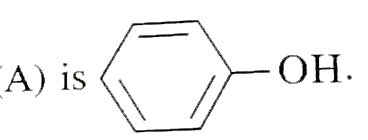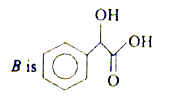An organic compound (A) has 76.6% C, 6.38% H. Its vapour density is 47. It gives characteristic colours with FeCl3 solution. (A) when treated with CO2 and NaOH at 120∘C under pressure gives (B) which on acidification gives (C). (C) reacts with acetyl chloride to give (D) which is a well known pain killer. Identify (A), (B), (C) and (D) and also explain the reactions.
The simplest ratio between the atoms may be calculated as :
C=76.6=76.612=6.381.06=6,H=6.38=6.381=6.381.06=6
O=17.02=17.0216=1.061.06=1 [Pencentage of O=100−(76.6+6.38)=17.02]
Empirical formula =C6H6O
Empirical formula mass =6×12+6×1+16=94
Molecular mass =2×Vapour density=2×47=94 (Given)
n=Molecular massEmpirical formula mass=9494=1
Molecular formula =(Empirical formula)×n=94×1=94
Since (A) give characteristic colour with aqueous FeCl3, it must be a phenol of (A) is 
The chemical reactions involved may be listed as follows :

Topper's Solved these Questions
- ALCOHOLS AND PHENOLSBOOK - DINESH PUBLICATIONCHAPTER - ALCOHOLS AND PHENOLSEXERCISE - PROBLEM FOR PRACTICE
39 Videos
- ALCOHOLS AND PHENOLSBOOK - DINESH PUBLICATIONCHAPTER - ALCOHOLS AND PHENOLSEXERCISE - ASSIGNMENT
46 Videos
- ALCOHOLS AND PHENOLSBOOK - DINESH PUBLICATIONCHAPTER - ALCOHOLS AND PHENOLSEXERCISE - HIGHER ORDER THINKING SKILLS
8 Videos
- ALDEHYDES AND KETONES BOOK - DINESH PUBLICATIONCHAPTER - ALDEHYDES AND KETONES EXERCISE - Interger
5 Videos
Similar Questions
An organic compound (A) has 76.6% C and 6.38% H. Its vapour density is 47. It gives characteristic colour with FeCl3 solution. (A) when treated with CO2 and NaOH at 140∘C under pressure gives (B) which on acidification gives (C ). (C ) reacts with acetyl chloride to give (D) which is a well known pain killer. Identify (A), (B), (C ), (D) and explain the reactions involved.
View SolutionAn organic compound (A) has 76.6% C and 6.38% H. its vapour density is 47. it gives characteristic colour with FeCl3 solution. (A) when treated with CO2 and NaOH at 140∘ C under pressure gives (B) which on being acidified gives (C). (C) reacts with acetyl chloride to give (D) which is a well known pain killer. identify (A), (B), (C), (D) and explain the reactions involved.
View Solution
Knowledge Check
An organic compound with molecular formula C6H6O dissolves in NaOH and gives characteristics colour with neutral FeCl3. On treatment with bromine water it gives tribromoderivative. The compound is,
AalcoholsBketonesCethersDphenolCompound (A) C8H6O2 on treatment with aq. NaOH followed by acidification gives (B) C3H2O3 which on oxidation gives benzoic acid only:
A B
B C
C D
D
An organic compound (A) with molecular formula C6H6O gives a characteristic colour with aqueous FeCl3 solution. When (A) is treated with CO2 and NaoH at 410 K under pressure, it gives compound (B) which upon acidification gives compound (C). compound (C) reacts with acetyl chloride to give (D) which is a popular pain killer. deduce the structure of (A), (B), (C) and (D) and explain all the reaction involved.
View SolutionAn organic compound 'A' having molecular formula C6H6O gives a characeristic colour with aqueous FeCl3 solution. When 'A' is treated with CO2 and NaOH at 400K under pressure, compound 'B' is obtained. The compound 'B' upon acidification gives compound 'C' which reacts with acetyl chloride to form 'D'. It is a polular pain killer. Deduce the structures of A, B, C and D.
View SolutionAn organic compound 'A' having molecular formula C6H6O gives a characteristic colour with aqueous FeCl3 solution. When 'A' is treated with CO2 and NaOH at 400K under pressure. 'B' is obtained. B on acidification gives C when C treated with CH3COCl gives a popular pain killer D. Deduce the strucutrues of A,B,C and D.
View SolutionAn organic compound 'A' having molecular formula C6H10O gives a characteristic colour with aqueous FeCl3 solution. When 'A' is treated with CO2 and NaOH at 400K under pressure. 'B' is obtained. B on acidification gives C when C treated with CH3COCl gives a popular pain killer D. Deduce the strucutrues of A,B,C and D.
View SolutionAn organic compound A(C2H6O) reacts with sodium to form a compound B with the evolution of H2 and gives a yellow compound C when treated with iodine and NaOH. When heated with conc. H2SO4 at 413 K, it gives a compound D(C4H10O) which on treatment with cone. HI at 873 K gives E. D is also obtained when Bis heated with E. Identify A, B, C, D and E and write equations for the reactions involved.
View SolutionMagnesium on heating in air gives (A) and (B). On reaciton with water (B) gives a colourless gas (C).(C) when passed through CuSO4 solution, gives a blue coloured solution (D). Identify (A),(B),(C) and (D).
View Solution
